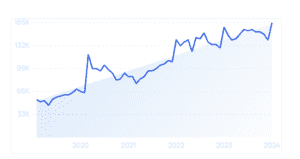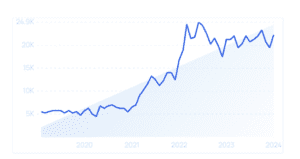
29 remote work stats 2024 that show its not going anywhere

As the madness of the ‘Covid-19-era’ fades to little more than a memory, it’s safe to assume that everyday life is now back to normal – especially within the world of Digital PR.
Though, normal means many different things to different people, are things really ‘back to normal’? What exactly is the new normal?
Other than the price of petrol, the price of groceries… the price of everything, really – things just seem to be generally a bit harder than they were before. However, I’d beg that one of the silver linings to it all is the new approach to a work-life balance.
Gone are the days of a two-hour commute, 5-days-a-week, and paying through the nose for parking at NCP. The time and money spent today are a fraction of what they once were – thanks to remote work.
It seems as though most employers now offer either hybrid or remote working models, however, what are the actual current remote working trends compared to what they were pre-pandemic? The stats below shine a light.
To learn more about working insights, contact our team by phone at 0161 327 2635 or email info@embryo.com.
Stats on Remote and Hybrid Work
- Pre-pandemic, 6% of US employees worked remotely, WISERD noted this to be 4.7% in the UK.
- Now a quarter of employees officially work remotely both in the UK and the US.
- Upwork states this is an 87% increase from pre-pandemic levels.
- Searches for ‘remote work’ are up 203% since 2019.

‘Remote Work’ Image source: Exploding Topics
- However, just after the pandemic, a survey by salary.com shows that only 5% of employers planned to continue with remote working post-pandemic, and 40% of employers are now encouraging employees to return to the office more regularly.
- ‘Hybrid working’ searches started climbing in 2021, this is often the more popular option for employers.

‘Hybrid Work’ Image source: Exploding Topics
- ONS states that 39% of the UK workforce is unable to work from home at all due to their type of work.
- In the summer of 2023, 29% of the UK worked from home some of the time, and 10% worked fully remotely.
- Tuesday is the most popular work-from-home day, at 67% of people.
- Monday is the least popular work-from-home day, with 57% of hybrid employees going into the office to kick off the week.
- 78% of employees stated that the main reason they enjoy working remotely is an improved work-life balance.
- Followed by just over half of employees saying they were quicker to finish work due to fewer distractions.
- On the flip side, 48% of employees said working from home makes it harder to collaborate with colleagues by working from home.
- Employers that have chosen to adopt the hybrid/remote working model said they host fewer overheads, and nearly 80% reported that they had better staff wellbeing.
- Surprisingly, for those who are able to work from home but choose to go into the office, Gen Z is the most popular cohort – at 14% of people.
- Millennials stood at 9%, making them the age group that prefers to work from home the most.
- 68% of people without a degree choose to travel to the office, compared to 33% of those who have a degree.
- Statistically speaking, those who earn more money prefer to work from home:
- £30,000-£40,000 – 49% WFH.
- £40,000-£50,000 – 60% WFH.
- £50,000+ – 80% WFH.
- Morgan McKinley found in their Global Workplace Guide that 51% of employees would turn down a pay rise in order to keep their working flexibility.
- 93% of employees expressed a strong preference to continue with hybrid or remote working.
- Only 3% of employees are happy to be in the office 5 days a week.
- Of those surveyed who did work 5 days a week in the office, 56% of them were actively looking for new roles.
- Only 74% of UK workers agreed that work is ‘rather’ or ‘very important’ to their lives. This compares to 96% in Italy and Spain, and 94% in France – according to HuffPost. It shows that the UK’s workforce is changing their approach to work in favour of a better work-life balance.
- According to Marketing Week, 58% of Marketers take the hybrid approach to work – Embryo included.
- 17% are fully flexible.
- Just under 6% of SMEs have closed their doors entirely to be fully remote.
Pre-pandemic, the offer of hybrid or remote working was very rare – It’s now the opposite.
A compulsory five office days a week is the minority, (for professions that don’t need to be, that is). There is a clear demand for this from employees and employers should probably think twice before asking staff to come back full time with no flexibility. The requirement of a full week of facetime at work would be a lot to put most staff off, and would more than likely make you quite an undesirable employer as well.
Remote working isn’t going anywhere anytime soon, it’s one of the few benefits to come out of the pandemic to help Brits achieve a better work-life balance.
To learn more about working insights, contact our team by phone at 0161 327 2635 or email info@embryo.com.


